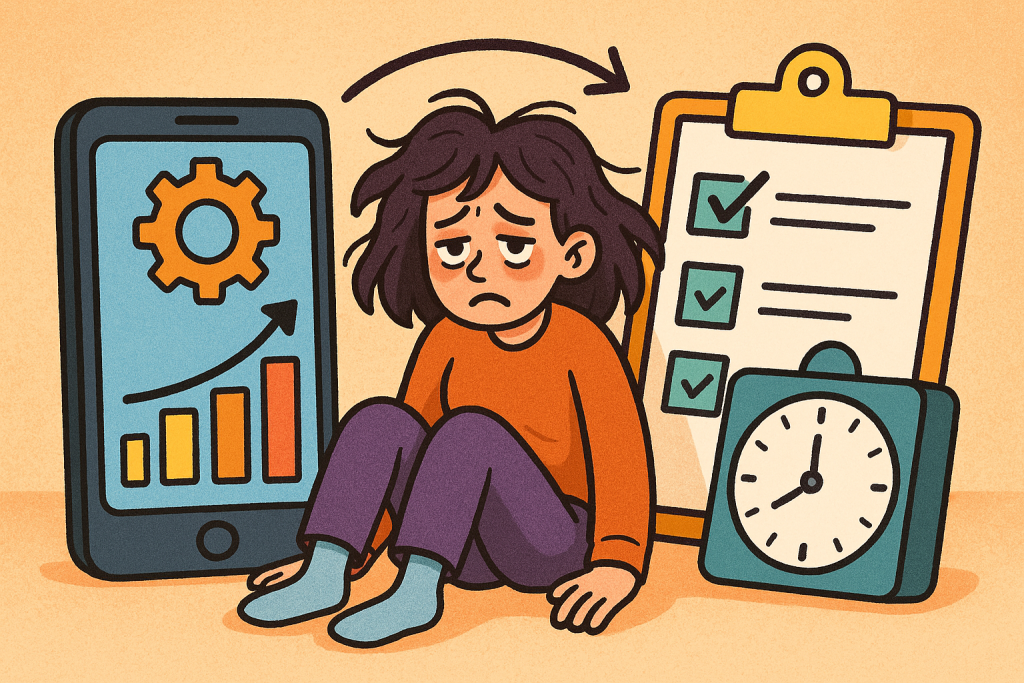In a culture obsessed with efficiency, “constant optimizing” has become the new norm—but at what cost? From burnout to toxic productivity, the emotional toll is mounting. Here’s why you should care and how to reclaim your well-being.

Why “constant optimizing” matters now
The term emotional cost of constant optimizing describes the growing strain people face when productivity and self-improvement dominate daily life. From goal-tracking apps to AI-driven workflows, there’s always a new metric to hit. But recent research shows this relentless push leads to burnout, anxiety, and damaged mental health.
- A Harvard Business School study found burnout correlates with lower efficiency, impaired decision-making, and higher turnover.
- 80% of employees report “productivity anxiety,” linking heavy optimization demands to worsening well-being.
Clearly, the mental price tag of optimization isn’t just theoretical—it affects real lives and real outcomes.
The rise of toxic productivity
First coined recently, toxic productivity describes the unhealthy obsession with being productive at all times. As Vogue notes, it stems from guilt, perfectionism, and a cultural push to optimize every waking moment. The effects include:
- Chronic guilt when off-task
- Difficulty relaxing even during breaks
- Symptoms like stress, insomnia, and emotional exhaustion
The phrase emotional cost of constant optimizing encapsulates both personal sacrifice and emotional burnout driven by this toxic mindset.
How our brains take the hit
1. Allostatic load: stress baked into our biology
Constant planning, tracking, and tweaking activates our stress systems continuously. Over time, this allostatic load can alter brain function, raise blood pressure, and worsen mood disorders.
2. Maximization vs. satisficing
Studies show maximizers—those striving for the best choices—often experience more regret, stress, and lower satisfaction than “good-enough” satisficers .
3. Perfectionism fueled by tech
Digital culture encourages perfection—constant tweaks to social media posts, constant A/B testing of emails. But excessive perfectionism links directly to anxiety, depression, and obsessive-compulsive behaviors.
The role of AI and performance pressure
New research shows AI adoption in workplaces, while boosting efficiency, also raises job stress—a major mediator of burnout. Even though AI doesn’t directly cause burnout, it fuels stress, especially among those who doubt their ability to learn new systems. Moreover, a sense of never being “optimized enough” amplifies the emotional cost of constant optimizing.
Real-world effects: burnout, anxiety, meaninglessness
- Academic staff report burnout tied to productivity pressures.
- Goal failure and chronic underperformance are linked to anxiety and depression.
- Poor mental health is projected to cost the global economy 6 trillion US dollars annually by 2030
This isn’t just personal; it’s an organizational and societal crisis. Workplaces that reward constant tweaking may inadvertently be pushing employees toward emotional collapse.
Coping with the emotional cost of constant optimizing
1. Prioritize purpose over perfection
Shift from maximizing to satisficing—good enough can be powerful. Embrace meaningful tasks without metrics.
2. Reclaim downtime
Schedule non-achievement activities: reading, walking, or creative play. Use regular rest breaks to reset.
3. Set boundaries around technology
Turn off app notifications. Allocate specific “no-optimize” hours daily to mentally unplug.
4. Practice mindful reflection
Rather than chasing efficiency, check in with your mental state. A 12-week study of positive affect journaling significantly reduced distress.
5. Build supportive workplace culture
Employers must treat mental health as a structural priority. Solutions like burnout training, flexible schedules, and realistic goals are essential .
A shift toward balance
Moving away from constant optimization isn’t about rejecting productivity—it’s about redefining it. Real productivity includes rest, mental health, and meaningful connections. As Svend Brinkmann’s critiques of self-optimization point out, meaning often comes from external engagement and limits—not from endless self‑tweaking.
Key takeaways
- Acknowledge the emotional cost – constant optimizing can wear you down biologically and psychologically.
- Understand your optimization triggers – perfectionism, AI tools, and performance culture all play a role.
- Adopt healthier habits – prioritize simplicity, purpose, rest, and reflection.
- Demand change at work – sustainable systems require systemic support, not just individual resilience.
Conclusion
The emotional cost of constant optimizing is real—and escalating. By recalibrating how we approach efficiency and productivity, we can reclaim time, mental health, and genuine happiness. It starts with recognizing that better doesn’t always mean more optimized, and ends in finding purpose beyond performance metrics.
References
Schneider, E. E. (2025). What Is Toxic Productivity? Vogue. Retrieved from https://www.vogue.com/article/what-is-toxic-productivity
Zhang, M., & Fah, L. Y. (2025). The influence of emotional intelligence on learning burnout in Chinese art college students: The chain mediation effect of self‑acceptance and perceived stress. Frontiers in Psychology, 15, 1432796. Retrieved from https://www.frontiersin.org
Centre for Mental Health. (2024). The Economic and Social Costs of Mental Ill Health. Retrieved from https://www.centreformentalhealth.org.uk






